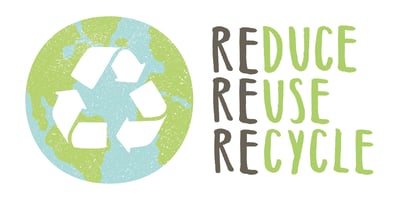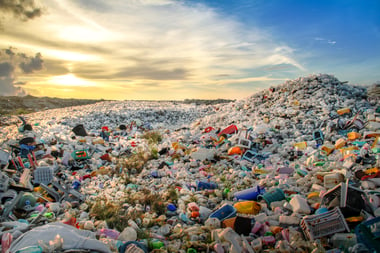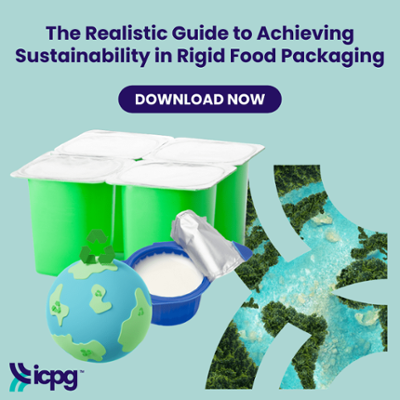 The quest to develop a sustainable packaging solution that delivers on key packaging and performance requirements can often leave one feeling like Goldilocks when visiting the home of the three bears:
The quest to develop a sustainable packaging solution that delivers on key packaging and performance requirements can often leave one feeling like Goldilocks when visiting the home of the three bears:
-
- This one isn’t recyclable
- This one increases material consumption
- This one doesn't offer process compatibility
In the face of a list of solutions that seem to create more objections than solve problems, how do you find the solution that is ‘just right'?
For years, the 'The Three R’s of Recycling’ - Reduce, Reuse, Recycle - have represented a catchy way to communicate best practices for waste management and encourage consumers to think more about their consumption and what they can do to "close the loop" by making recycling a priority.
As strategies to develop more stringent waste management and disposal practices have come to the forefront of consumer goods discussions, some organizations have begun to expand this to encompass "Four R's" - reduce, reuse, recycle, rethink; or - review, reduce, reuse, recycle. Look up the "Four R's of Sustainability" and you'll see various words to fill in the fourth. But whether you use the word "review" or "rethink" the main difference between the 'Three R's of Recycling' and the 'Four R's' is the concept of redesign - or more specifically, redesign with sustainability in mind. The incorporation of a fourth "R" emphasizes that unless a product is designed with end-of-life, or second-life, in mind that product runs a risk of contributing to the global waste issues we are all facing.
ICPG is in the business of producing plastic packaging materials, and we place a serious emphasis on helping brands and converters redesign products in a way that helps them achieve their internal goals while doing their part to make an impact in the war on waste. So when it comes to evaluating plastic packaging materials, what is important to consider? There are probably a few key considerations that come to mind right off the bat - but in our years of working with a variety of materials we have come to realize that the case for sustainability in packaging is highly nuanced, and there are many factors that contribute to the full-picture for a given solution.
In this three part series, we will help you take the first step to rethink considerations for eco-conscious material selection as it pertains to the "Three R's of Recycling” starting with reduce:
The reduce component of the three r's refers to cutting back on the amount of waste we generate. In a consumer's home, this could mean bringing reusable shopping bags to the grocery store to cut down on the amount of plastic or paper bags consumed. Or it could mean, using a refillable water bottle to reduce the amount of plastic bottles used in the home. Further upstream in the supply chain, this could mean finding opportunities to down-gauge existing structures as a means of reducing the material requirements, or packaging design that enables use of a polymer with a lighter density.
According to The World Bank's "Managing plastic and food waste for a sustainable future," factors including increased economic growth and a higher income per capita, coupled with projected population growth of 3 billion by 2050 are expected to increase material use. The "Future scenarios of global plastic waste generation and disposal" estimates the impact of mismanaged plastic waste, under three different scenarios:
-
- Scenario A: Business as usual. Based on demand projections, global mismanaged waste will triple by 2060 from 80 metric tons/year to 213.
- Scenario B: Improved waste management. With improved waste management infrastructure across the globe, global mismanaged plastic waste decreases from 80 metric tons/year to 50 by 2060.
- Scenario C: Reduced plastic use and improved waste management. With improvements realized under scenario B, and reduced plastic waste / waste management plastic in households, plastic waste is halved to 5% of municipal solid waste by 2040. See the interactive map here.
Reduce Consumption

Currently, plastics account for about 1/5th of waste, so there is significant opportunity to contribute to the overall goal of waste reduction through substitution and responsible material selection. When considering the scenarios above, designing - or redesigning - food packaging using materials that inherently reduce waste is a good place to start, since it can affect the downstream impact of the product.
How Can Packaging Materials Adhere to the Three R’s of Recycling?
In plastic packaging, material choice can directly impact material consumption & material requirements because of the density and weight associated with different plastic materials. Certain materials have an increased density while others have a reduced density. This density difference can impact part yield in thermoforming & form fill seal processes. As density is reduced, all else equal, the same amount of formed parts can be produced using less material, thus resulting in a more efficient use of resources.
Take the example below, which illustrates the impact on material requirements for a higher vs lower density material in comparison to 10MM lbs of PS:
| Material | Density / Yield Factor | Consumption vs PS (lbs) |
| PS | 1.04 | 10,000,000 |
| PET | 1.33 | 12,780,000 |
| PP | 0.91 | 8,800,000 |
Based on the example above, keeping the implications of density on material requirements in mind, it is clear that making the effort wherever possible to use a less dense polymer can have a drastic impact on overall material consumption and even result in increased resource efficiency. In addition, by choosing alternatives that reduce the amount of plastic consumption by requiring less material at the start of the product lifecycle it creates a scenario in which brand owners are aiding the effort to reduce plastic before the product ever reaches the consumer.
Reduce Downstream Impact with the Three R's of Recycling
Some additional areas where packaging design and material selection can reduce environmental impact include:
Emissions
By extension of the density and weight of various plastic materials, there are downstream implications of using a heavier vs lighter material in the form of emissions. Using a material that carries a lower density and thus a lighter weight can result in further reductions throughout the product lifecycle including:
- Reduced carbon footprint & reduced CO2 equivalents by weight;
- Less solid waste by weight;
- Lower fuel consumption & lower emissions
Food Waste
 Each year, the food industry loses roughly ~$15B due to food spoilage. According to the USDA, in the US alone 40%, or 135 billion tons, of the food that reaches retailers and consumers is wasted. This spoiled food in-turn ends up in landfills, contributing to the largest component of US municipal solid waste. This presents a serious issue not just because of the staggering inefficiencies and wasted opportunities regarding the concept of wasted food, but also because of the humanitarian, environmental and economic consequences that will only become more pressing as the global population continues to expand. From an environmental standpoint, resources used including water, land and fossil fuels and resulting emissions generated throughout the product lifecycle are simply unnecessary if that food ultimately goes to waste. Not to mention, once food ends up in the landfill it generates methane gas, a greenhouse gas that is 84 times stronger than carbon dioxide.
Each year, the food industry loses roughly ~$15B due to food spoilage. According to the USDA, in the US alone 40%, or 135 billion tons, of the food that reaches retailers and consumers is wasted. This spoiled food in-turn ends up in landfills, contributing to the largest component of US municipal solid waste. This presents a serious issue not just because of the staggering inefficiencies and wasted opportunities regarding the concept of wasted food, but also because of the humanitarian, environmental and economic consequences that will only become more pressing as the global population continues to expand. From an environmental standpoint, resources used including water, land and fossil fuels and resulting emissions generated throughout the product lifecycle are simply unnecessary if that food ultimately goes to waste. Not to mention, once food ends up in the landfill it generates methane gas, a greenhouse gas that is 84 times stronger than carbon dioxide.
A significant opportunity exists for thoughtful and careful packaging choices that adhere to the three R’s of recycling to play a critical role in reducing the amount of food waste - from design, to material selection, to incorporation of barrier technologies that extend shelf-life. The organization Rethink Food Waste through Economics and Data (ReFED) estimates that development of packaging solutions that extend product shelf-life have the potential to divert 72,000 tons of food waste, from landfills in the US alone, which would equate to reducing greenhouse gas emissions by 329,000 tons per year.
PCR Materials
Incorporation of food-grade post-consumer recycled (PCR) materials into packaging material structures presents an opportunity for brand owners to further reduce the environmental impact of packaging solutions by cutting down on the percentage of virgin resin material used in their packaging. Innovations in PCR technologies such as the advanced recycling PP purification processes developed by PureCycle Technologies, present the opportunity for brand owners to reduce the percentage of virgin materials used in packaging without compromising health & safety or material performance.
To learn more about how you can align your environmental packaging solution with the three R’s of recycling, check out ICPG's sustainable material replacement solutions for thermoformed and form fill seal food packaging:





